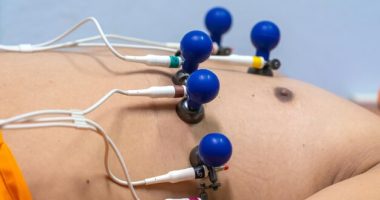In an innovative push to enhance breast cancer monitoring, a recent study led by Luiz Fernando de Queiroz and his team delved into the molecular landscape of the disease by examining gene methylation patterns. The study, published in a prestigious journal, ambitiously targeted the methylation status of two critical genes, CDKN2A/p16INK4A and RB1, known for their roles in cell cycle regulation and cancer suppression. The researchers collected samples from 15 women who had undergone total mastectomy due to breast cancer, analyzing DNA extracted from tumor tissues, adjacent non-tumor tissues, and peripheral blood.
Their approach was distinctly comprehensive: they compared methylation patterns in cell-free DNA from blood samples taken on the day of surgery and one year later. The use of sodium bisulfite conversion followed by polymerase chain reaction and electrophoresis provided precise methylation profiles. The findings revealed notable patterns in the methylation of CDKN2A/p16INK4A and RB1, not only in tumor tissues but also in non-tumor tissues and circulating DNA.
This pioneering study introduces a promising method for continuous breast cancer monitoring through non-invasive means. By detecting shifts in DNA methylation patterns from circulating blood, this method could potentially signal cancer recurrence before physical symptoms manifest, opening new avenues for preemptive cancer care and management. Such molecular insights are crucial for understanding the dynamics of breast cancer progression and recurrence, possibly guiding future therapeutic strategies.
The novel research conducted by Luiz Fernando de Queiroz and his team builds on a substantial foundation of understanding the mechanisms by which breast cancer develops and progresses. Breast cancer, which remains one of the leading causes of cancer-related deaths among women globally, is deeply influenced by genetic and epigenetic alterations that regulate cell growth and division. Specifically, gene methylation is a key epigenetic mechanism implicated in the onset and progression of various cancers, including breast cancer.
Epigenetics, particularly DNA methylation, involves the addition of a methyl group to DNA, predominantly at cytosine-phosphate-guanine (CpG) sites, leading to the regulation of gene expression without altering the underlying DNA sequence. Methylation typically reduces gene expression and can have pivotal consequences when occurring in genes vital for cell cycle control and tumor suppression. In the context of breast cancer, aberrant methylation patterns often contribute to the tumorigenesis by inactivating tumor suppressor genes and activating oncogenes.
The focus on the genes CDKN2A/p16INK4A and RB1 in their study is particularly significant. The gene CDKN2A encodes for the p16INK4a protein, a crucial inhibitor of cyclin-dependent kinases involved in the cell cycle regulation. The loss of function through hypermethylation of the CDKN2A/p16INK4A gene has been frequently associated with various cancers, highlighting its importance in maintaining normal cell cycle control. Similarly, RB1 plays a critical role in regulating the cell cycle by preventing excessive cell growth and division, with its inactivation, often via methylation, linked to several cancers.
Previous research has extensively documented the methylation statuses of these genes in broad cohorts, but the approach by de Queiroz and colleagues provides a deeper integrative perspective by analyzing not only tumor DNA but also adjacent non-tumorous tissue and circulating tumor DNA (ctDNA). This holistic view allows for a more detailed understanding of the disease state and its progression, potentially offering a dynamic picture of the cancer beyond the static scenario provided by a single tissue sample taken at one time point.
The method of using non-invasive blood samples to monitor disease status is an exciting frontier in cancer research. Known as a “liquid biopsy,” this technique offers great promise for ongoing monitoring of cancer patients, detecting early signs of recurrence or response to therapy. By comparing methylation patterns in circulating DNA over time, researchers can potentially track the genomic evolution of the tumor and intervene at an early stage if recurrence is detected.
Further, the timing of the samples in this study—on the day of surgery and one year later—provides essential insights into the temporal dynamics of methylation changes, facilitating a better understanding of the patterns of cancer recurrence or remission. This could be critical in developing personalized treatment plans, adjusting treatments based on molecular changes, and potentially improving patient outcomes.
Through their pioneering work, Queiroz and his team are contributing to a shift in how breast cancer is monitored post-treatment, aiming to enhance the precision and efficacy of follow-up care and open new avenues for preemptive therapeutic strategies. This research not only refines our understanding of breast cancer biology but also sets the stage for future innovations in the non-invasive monitoring of cancers.
To delve into the molecular landscape of breast cancer and track changes in DNA methylation patterns, the methodology adopted by Luiz Fernando de Queiroz and his team was aimed at being both comprehensive and precise. The study focused on the methylation status of the genes CDKN2A/p16INK4A and RB1, which are critical to cell cycle regulation and are often implicated in cancer when they exhibit altered methylation patterns.
To begin, samples were carefully collected from three different sources for each of the 15 women undergoing total mastectomy: tumor tissues, adjacent non-tumor tissues, and peripheral blood. This multi-source sampling strategy was crucial for providing a thorough view of the methylation landscape both within and surrounding the cancerous cells, as well as in the circulating DNA within the bloodstream.
The DNA extraction from these samples was performed using established protocols to maintain integrity and prevent degradation. Following extraction, the DNA underwent sodium bisulfite conversion, a critical step for methylation studies. This conversion treatment chemically alters unmethylated cytosine residues to uracil, leaving methylated cytosines unchanged, thereby creating a distinct pattern that reveals the methylation status of the DNA once amplified and sequenced.
Subsequently, polymerase chain reaction (PCR) was utilized to amplify the regions of interest within the CDKN2A/p16INK4A and RB1 genes. This targeted approach allows for the selective enrichment of specific DNA sequences, making the subsequent analysis more manageable and focused. Amplified products were then subjected to gel electrophoresis. This technique separates the DNA fragments based on size, enabling the researchers to visualize the results directly and assess the methylation patterns.
The data from gel electrophoresis were meticulously analyzed to identify differences in band patterns, which indicate variations in methylation. Special attention was given to comparing the results across different types of samples — from tumor tissues, adjacent non-tumor tissues, and circulating DNA in peripheral blood. This comparison not only facilitated an understanding of methylation changes within the tumor microenvironment but also allowed the researchers to trace these patterns in the bloodstream, giving insight into the systemic impact of cancer at a molecular level.
To ensure accuracy and reproducibility, the researchers performed multiple replicates of each test and included controls to detect any potential contamination or procedural errors. The PCR conditions, such as annealing temperatures and cycle number, were optimized to yield consistent results across all samples.
Moreover, to track the dynamics of methylation changes over time, blood samples were collected both on the day of surgery and one year post-surgery. This longitudinal approach offers a unique temporal perspective, allowing the team to monitor for changes in methylation patterns that might indicate recurrence or continued remission.
Through this rigorous methodological approach, Luiz Fernando de Queiroz and his team have provided a novel insight into the landscape of breast cancer methylation, showcasing a non-invasive, dynamic method for monitoring cancer progression and recurrence with potential implications for personalized treatment strategies.
Those key findings by Luiz Fernando de Queiroz and his team revealed intriguing methylation patterns that hold significant implications for the monitoring and treatment of breast cancer. The specific results showed differential methylation levels of the CDKN2A/p16INK4A and RB1 genes across the three sample types: tumorous tissue, adjacent non-tumorous tissue, and circulating DNA in peripheral blood.
The research revealed that methylation of the CDKN2A/p16INK4A gene was significantly higher in tumor tissues compared to adjacent non-tumorous tissues. This hypermethylation pattern was consistent with the gene’s role as a tumor suppressor. Hypermethylation in tumor tissues often leads to the silencing of the gene, thereby contributing to unchecked cellular proliferation and tumor development. Interestingly, a similar but less pronounced methylation pattern was observed in the adjoining non-tumor tissues, suggesting an extended area of influence, possibly indicating a field effect or regional propagation of epigenetic modifications in cancerous tissues.
For the RB1 gene, the study observed a more moderate increase in methylation in tumor tissues compared to non-tumor tissues, but the changes were significant enough to suggest a role in tumor behavior. The RB1 protein is instrumental in controlling the cell cycle, and its inactivation via methylation could disrupt cell cycle regulation, leading to cancer progression.
Moreover, analyses of circulating cell-free DNA from blood samples showed discernible patterns of methylation for both genes not only on the day of surgery but significantly reported consistent findings one year post-surgery. This result indicates that DNA shedding from tumor cells into the bloodstream can be detected over time and could serve as a continuing marker for the presence or absence of disease.
A crucial finding of this study was the detection of specific methylation signatures in peripheral blood that closely mirrored those in tumor tissues. These signatures could potentially serve as biomarkers for breast cancer detection and monitoring, offering a non-invasive method to assess tumor dynamics and the impact of therapeutic interventions. The persistent detection of methylation in blood samples one year after surgery was particularly promising for long-term monitoring, suggesting that this method could help to detect recurrence early and monitor therapeutic effectiveness.
Interestingly, the study also found that changes in methylation patterns over the one-year period post-surgery varied among patients, which underscores the potential of personalized cancer management. Those variability in methylation changes suggests that each patient’s tumor has a unique epigenetic trajectory, which could inform tailored treatment strategies and adjustment of treatments over time based on the molecular evolution of their disease.
In conclusion, the study performed by Luiz Fernando de Queiroz and his team provides compelling evidence that monitoring methylation patterns of key genes in circulating tumor DNA is feasible and informative. This method presents a futuristic approach to ongoing, non-invasive cancer surveillance, opening up exciting possibilities for early intervention and personalized management of breast cancer. Further studies and clinical trials would be needed to refine this approach and validate its clinical utility in broader patient populations.
The groundbreaking research conducted by Luiz Fernando de Queiroz and his team represents a pivotal step forward in the realm of oncology, particularly in the monitoring and management of breast cancer. By leveraging detailed methylation analysis of critical genes like CDKN2A/p16INK4A and RB1, this study underscores the potential of epigenetic markers in providing dynamic insights into cancer progression and recurrence. However, despite the promising results, there are several avenues and challenges that future research needs to address to optimize and implement this innovative methodology in routine clinical practice.
**Future Directions in Research and Clinical Applications**
1. **Extended Validation and Replication**: Further studies involving larger and more diverse cohorts are necessary to validate the findings from Queiroz’s team. Expanding the research to include a broader demographic will help confirm if the observed methylation patterns hold universally across different populations and cancer subtypes.
2. **Integration with Other Biomarkers**: Combining DNA methylation analysis with other molecular or imaging biomarkers could enhance the sensitivity and specificity of breast cancer detection and monitoring. Future research could investigate how these combined approaches could offer a more comprehensive diagnostic tool, potentially incorporating genomic, transcriptomic, and proteomic analyses.
3. **Long-term Monitoring and Clinical Trials**: Longitudinal studies observing patients over extended periods can provide further evidence on the efficacy of methylation-based surveillance in detecting recurrence. Clinical trials could explore how early adjustments in treatment, guided by shifts in methylation patterns, might impact patient outcomes.
4. **Technological Advancements**: Continued technological improvements in DNA sequencing and methylation analysis will be critical. More refined techniques could provide quicker and more accurate results, essential for the real-time application of this method in clinical settings.
5. **Personalized Treatment Regimens**: With further understanding of individual methylation patterns, oncologists could tailor treatments more precisely to the epigenetic profile of each patient’s tumor. This approach might include decisions on the use of specific drugs, the timing of interventions, and the combination of treatments that best suit the molecular characteristics revealed through methylation analysis.
**Final Thoughts**
The study spearheaded by Luiz Fernando de Queiroz illuminates the potential of methylation profiles as a tool for continuous, non-invasive monitoring of breast cancer, heralding a shift towards more personalized cancer care. As this research moves closer to clinical application, it promises not only to enhance our understanding of cancer biology but also to transform the prognosis and management of breast cancer patients globally.
Importantly, while the prospects are promising, the integration of such advanced molecular diagnostics into everyday clinical practice will require careful consideration of cost, accessibility, and the establishment of clear guidelines on how to interpret and act on methylation signals. Furthermore, addressing ethical, privacy, and data management issues will be crucial as these biological markers begin to play a more prominent role in patient care decisions.
Ultimately, the ongoing research following the path laid by studies such as that of Queiroz’s is moving towards a future where cancer treatment is not just reactive but anticipatory and finely adjusted to the molecular underpinnings of each patient’s disease. This paradigm shift not only aims at improving survival rates but also at enhancing the quality of life for breast cancer patients, offering hope through science-backed precision medicine.









